|
Une expérience de biologie au LSM : IRIs
The IRIS Project: Abstract for the DULIA-Bio workshop at Canfranc, October 2015
N. Lampe, P. Marin, V. Breton, D.G. Biron, M. Coulon, M. Davidkova, T. Hindré, S. Incerti, L. Maigne, P. Micheau, F. Piquemal, D. Sarramia, G. Warot
The IRIS (Impacts of ionising radiation on life) project aims to study the long term impacts of low dose ionising radiation on living systems. Whilst the short term impacts of radioactivity are well studied, the multi-generational impacts of chronic low-dose radiation exposure are not well understood, most of our knowledge coming from the elevated background-radiation environments created by nuclear disasters. We are conducting Long Term Evolution Experiments at both the Laboratoire Souterrain de Modane (LSM) and the Laboratoire de Physique Corpusculaire de Clermont-Ferrand (LPC) in order to measure the impact of ionising radiation on the appearance of genetic mutants in a population of bacteria, across time-scales long enough for natural selection to be important in genetic dynamics.
Currently, we have grown 200 out of an envisaged 500 generations of E. coli in a newly installed biology laboratory in the LSM, using an experimental set-up that reduces the radiative background by a factor of 30 compared to the LPC. This complements 850 generations of bacteria grown at the LPC following the same experimental protocol. Bacteria are grown in a glucose limited environment with the nutritive medium replaced every 24 hours. Across 500 generations of bacterial growth, at least one beneficial mutation (a mutation that increases competitive fitness) is expected to occur and reach fixation in a population. In the population grown at the LPC, we have observed through competition assays between evolved and ancestral strains the appearance of a fitness-increasing adaptation occurring between 300 and 400 generations of growth. Whilst it has not been verified that this variation is genetic in origin, this augmentation in competitive fitness is consistent with previous long term evolution experiments.
At both the LPC and LSM, we conduct fitness assays every 100 generations, with the possibility of narrowing this time window using strains frozen each fifty generations. We aim to show whether there is a difference in the evolutionary trajectory (measured by the competitive fitness relative to the ancestor) of the E. coli system when the radiative environment changes. Through measurements of the E. coli proteome, we will also be able to quantify the adaptative responses of the bacteria to the new environment, both genetic and epigenetic.
To understand the molecular damage experienced by the bacteria in each environment, the experimental program at the LPC is accompanied by a simulation of the impact of the radiative background on E. coli cells at both the LPC and the LSM using Geant4-DNA. The Geant4-DNA toolkit allows the interactions between radiation and matter to be simulated down to the eV-scale and can be used to simulate radiation induced DNA damage. We are building E. coli models within the Geant4-DNA framework, and will use these simulations to compare the LPC and LSM environments not just in terms of dosage, but also in terms of their respective impacts on the cell at the DNA level. Already, work has been done to determine the spectrum of secondary electrons created in water by the gamma background at the LSM, and this is being extended to understand the impact these secondary electrons have on the cells themselves. Radiation-induced DNA damage will be integrated into a multi-scale individual based model to describe bacterial population dynamics and evolution.
Presentation projet Iris (pdf - 2Mo)
Poster Graine de Chercheur "Zone Atelier Uranifère" (pdf - 2Mo)
IRIs : Impact des Radiations Ionisantes
 Les rayons cosmiques ou la radioactivité naturelle ont-ils une influence sur l'évolution des micro organismes ? Les rayons cosmiques ou la radioactivité naturelle ont-ils une influence sur l'évolution des micro organismes ?
La méthode de l'expérience IRIs consiste à créer des modèles simples permettant de simuler l'effet des radiations sur l'évolution d'une population bactérienne ... ce modèle pourra être applicable plus tard à la cellule humaine ...
Les travaux de Richard Lenski ( http://myxo.css.msu.edu/ ) consistent à remettre en culture toujours la même bactérie (Escherichia coli) depuis 1988. Depuis plus de 20 ans l'équipe de Richard Lenski a identifié de nombreuses modifications physiologiques et génétiques produites dans les souches évoluées. Dès 2000 générations les bactéries évoluées commencent à se multiplier plus rapidement, à 10000 générations leur taille et leur volume augmentent significativement et E.coli acquiert de nouvelles propriétés de dégradation de molécule (citrate). L'évolution de ces bactéries pendant de nombreuses générations est-elle due à l'environnement radiatif autour de la bactérie ou est-elle le fruit du hasard ?
Basé sur les travaux de Richard Lenski, le projet IRIS a pour but d'étudier l'évolution d'une bactérie dans un environnement où le niveau de radiation est plus faible. Pour cela nous utilisons le même modèle bactérien que R. Lenski. Cette bactérie a son génome séquencé et ces voies métaboliques bien caractérisées. Pendant plus de 3 mois la population E.coli a évolué dans un château de plomb à l'abri de certaines radiations au laboratoire souterrain de Modane pour atteindre les 200 générations d'évolution. Des expériences menées au LSM sont en cours pour identifier les bouleversements génétiques ou physiologiques qui ont pu se produire au fil de l'évolution de la bactérie.
Les premières expériences réalisées au LSM consistent à mettre en compétition dans le même milieu de culture une bactérie qui n'a pas évolué (formant des petites colonies) et des bactéries qui ont évolué pendant 200 générations formant des grosses colonies. Les bactéries évoluées doivent se multiplier plus rapidement puisque chaque jour on les transfère dans un milieu de culture fraichement confectionné. Elles acquièrent donc la capacité à se multiplier facilement, régulièrement et rapidement, ce qui n'est pas le cas des bactéries qui n'ont pas évolué (bactéries ancestrales)
Les résultats obtenus grâce à cette étude permettront de simuler l'évolution d'E.coli dans un environnement de faible radiation avec des modèles informatiques multi-échelle. De plus les mesures des particules ionisantes effectuées au LSM pourraient nous permettre d'établir en lien entre l'évolution des bactéries et le nombre / type de particules détectées.
Contact Microbiologie : Pierre Micheau, pierre.micheau63 [@] gmail.com
Une bactérie (~1µm) donne naissance à une colonie bactérienne après avoir été mise en incubation pendant 24h à 37°C sur un milieu nutritif contenant de l'arabinose (sucre de gomme), des extraits de levure et de la tryptone (peptone de caséine) dans une boite de Pétri 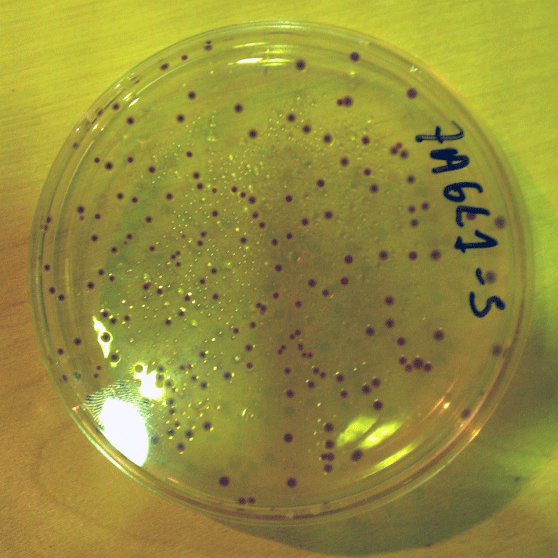
On dénombre les colonies bactériennes visibles à l'oeil nu (chaque point pourpre) en fonction de leur taille et de leur couleur 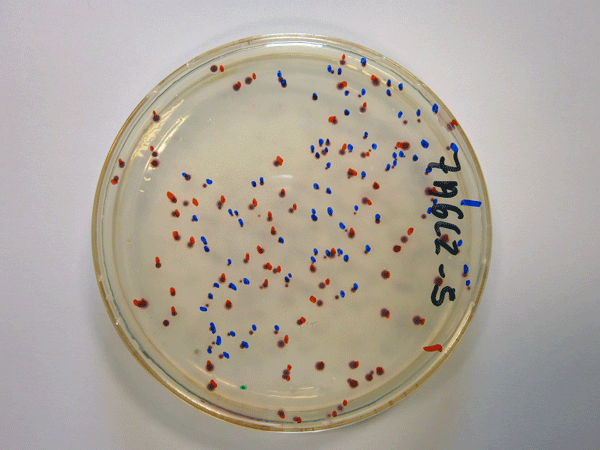
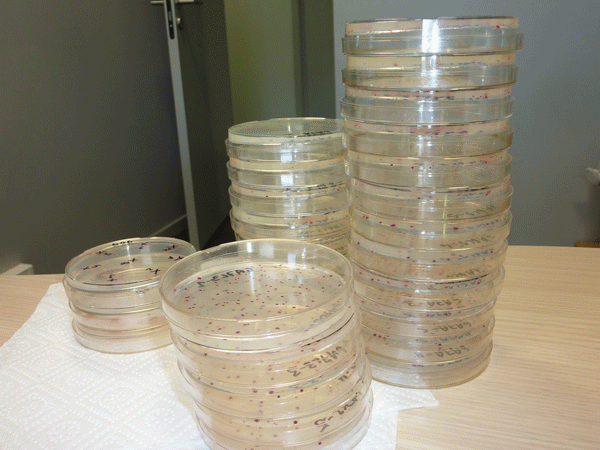
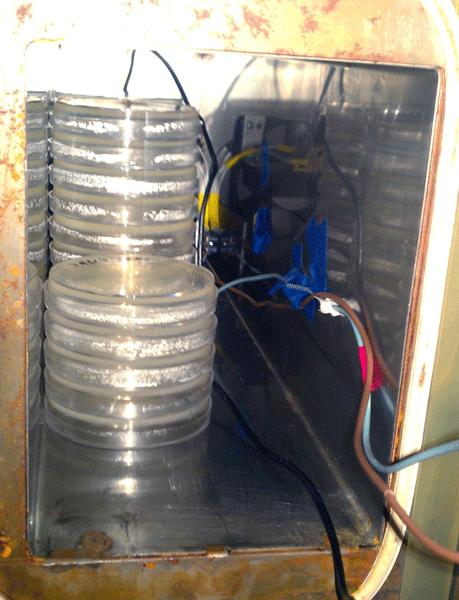
Une installation d'un genre nouveau pour un laboratoire de physique
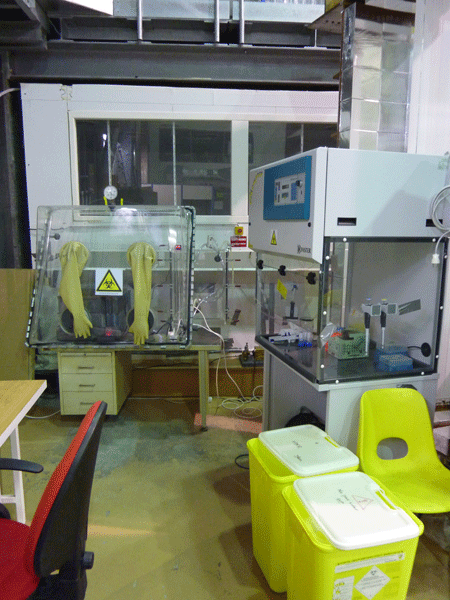

|



